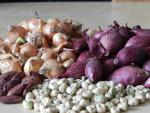 Although during this month we can often see the first signs of spring appearing with winter blooms popping up in gardens and along hedgerows, February can be an unpredictable month weather-wise meaning that you have to be careful about what you start to plant outside and when (although it is generally better to be a little patient and wait until March).
Although during this month we can often see the first signs of spring appearing with winter blooms popping up in gardens and along hedgerows, February can be an unpredictable month weather-wise meaning that you have to be careful about what you start to plant outside and when (although it is generally better to be a little patient and wait until March).Providing that the conditions are right and the ground is warm enough (a good indication of this is when the grass has started to grow) hardy seeds can be planted outdoors, but should be sewn under cover to protect them from any further frosty spells. If you live in an area with clay soil, then it might be best to wait a couple a weeks to let the ground warm-up.

Next on the list is to decide what you are going to grow. If you are new to growing vegetables, it is better to choose a few and look after them rather than trying to do too much all at once which will probably lead to numerous plants not growing successfully (starting with five different kinds is a good number). Onions and potatoes are a good place to start, along with salad vegetables.

February at a glance: Scrub pots and seed trays with hot, soapy water. Choose a few (five is good) different plants to grow. Plant seeds in small batches on warm windowsills. Label pots including the date the seeds were planted. Water well and rotate seed trays, keeping an eye on the weather.

